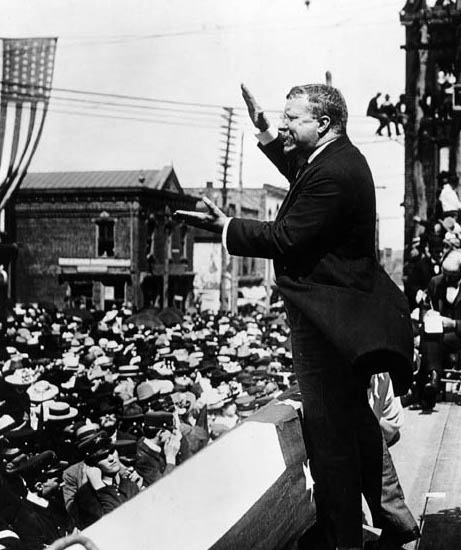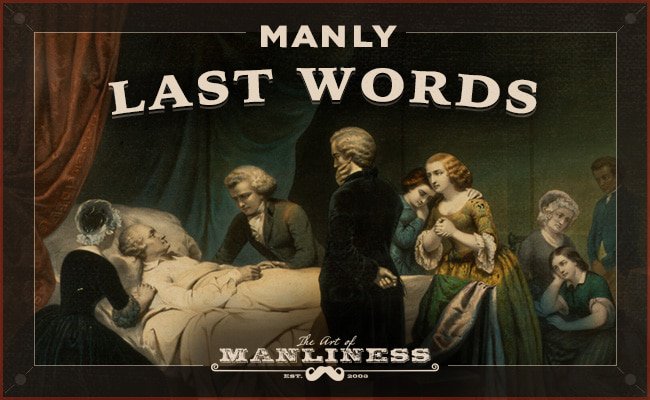
In the pursuit of becoming a better man, becoming well-spoken is a task that should not be overlooked. How you speak is a huge component of the impression you make on others, and thus your potential influence on them. People will form judgments about your education, intelligence, background, and personality simply based on the sound of your voice and the language you use to express yourself.
Being well-spoken encompasses a lot of traits:
- Creating well-formed sentences
- Being articulate
- Having a large and diverse vocabulary
- Speaking clearly (not mumbling)
- Having a good pace, tone, and intonation (not too loud, fast, or monotone)
- Being fluent – words come easily to you
- Being able to explain things easily
- Being straightforward and meaning what you say
- Being thoughtful and courteous to the needs of the listener
- Using little filler and empty language
We hope to cover all of these traits eventually, but today we’re going to concentrate on the last item on the list: removing the filler — particularly the um’s and uh’s — from your speech.
Ummmm…
What is filler? Filler consists of empty, extraneous language that pads your sentences without adding any additional meaning. It’s like empty calories – it’s there, but it doesn’t nourish. Examples of fillers include words and phrases such as “I mean,” “sort of,” “ya know?” “well,” and of course, “like.”
But the most famous fillers of all — the type that comes in for the most attention and disdain – are “uh” and “um.” To many, um’s and uh’s are tantamount to “verbal viruses” that clog up the language of the uncivilized and uneducated. Many public speaking experts recommend attempting to scrub your speech clean of this pesky padding.
The truth is that almost everyone uses these “filled pauses” in their speech; if you don’t think you do, it’s because speakers (and listeners in many cases as well), are very bad at hearing them. But if you were recorded throughout the day, you’d notice how much you sprinkle um’s and uh’s into your conversations. They are a very natural part of human speech and have likely been around since the beginning (although they vary according to language – such as “eh” in Spanish). In friendly conversation, as long as your fillers aren’t excessive or clustered together, people tend to filter them out and hardly notice them, if at all. Also, contrary to popular belief, fillers do not impede the listener’s comprehension; in fact, they can aid comprehension, signaling to the listener that you misspoke and are about to edit something you just said or to pay attention to what you say next.
This is not to say that you can’t control your um’s and uh’s or should use them indiscriminately. Rather, that the issue is simply not an all or nothing affair. The appropriateness of um’s and uh’s varies on a sliding scale, depending on your audience and your purpose. Researchers have found that a listener’s sensitivity to a speaker’s um’s and uh’s depends on the speaker’s social role. People expect those who are giving prepared remarks, on television, or in a position of authority to use little if any filler. For example, you would quickly notice if the play-by-play announcer for a basketball game said “um” before each sentence. “Um, Harden gets the ball. Um, he shoots and scores another three pointer. Um, his beard is awesome.” (Go Thunder!) This is also why President Obama gets lampooned on late night shows for his tendency to pepper his extemporaneous remarks with a bunch of uhhh’s and ummm’s.
Using uh and um too often takes away from the forcefulness and eloquence of your remarks. So while it’s not as big of a deal when used in conversations with friends, when meeting people for the first time and during job interviews, business presentations, formal speeches, and the like, you want to minimize your use of fillers as much as possible. If curbing your ummm-ing is something you struggle with, read on to learn why we all “um” and “uh” and what we can do to curb this tendency and become better spoken gentlemen.
Why Do We Say Um?
While it is popularly believed that um’s and uh’s arise because of anxiety, studies have not found a strict correlation between this type of filler and that emotional state (other “disfluencies,” however, like repeated words, the repeating of a single syllable or sound, omitting a word or part of a word, or a slip of the tongue are correlated with a speaker’s anxiety-level). For example, you are not more likely to use fillers when talking to a stranger than you are when talking to your spouse.
The reasons behind our uh’s and um’s are in fact a lot more nuanced (not to mention interesting). Here are some of the research-based theories that have been advanced:
Um’s and uh’s indicate that the speaker is “in trouble.” The primary view on the purpose of filler is that it is either an involuntary symptom or a purposeful signal (here linguists do not agree) that the speaker gives to indicate to his listeners that he is “in trouble” – he needs a moment to plan what to say next or to hunt for something in his memory. It tells the audience that there is about to be a delay. “Uh’s” signal a shorter delay, while “um’s” tell the audience the delay will be longer.
Basically, um’s and uh’s happen when you’re trying to think and speak at the same time. This is why they occur more frequently during transitions to a new topic or at the beginning of a sentence rather than at the end or in the middle of one; your brain is idling at the juncture between planning and executing what to say next.
Um’s and uh’s act as placeholders to let people know you’re going to continue speaking. When you can’t think of what to say next, you’re in a bit of a pickle; you need a moment to think about it, but social mores dictate that a pause can make you seem lost, or, provide a opportunity for someone else to jump in and start talking. So you may say “um” to tell your listeners: “I’m still in control – don’t interrupt me.”
This is one theory as to why men use more fillers like um and uh than women do: they are more assertive about holding the floor.
Uh’s can be a cry for help. Um’s and uh’s are not identical. In addition to the former signaling a longer delay in a person’s speech, uh’s are used more often to solicit help from others. They let listeners know they can jump in and provide the answer.
Harry: Jack was supposed to email, uh, uh…
Mike: Steven. He was supposed to email Steven.
Harry: Thanks
Um’s and uh’s indicate that we’re not as confident about what we’re about to say. When asked a question, people use more filler before responding when they’re less sure they have the right answer (and are in fact more likely to get the answer wrong). Conversely, people use less filler before giving an answer they’re sure is right (and one that is indeed more likely to be correct).
People also use more fillers before a non-answer like “I don’t know,” when they actually do know the answer, but simply can’t summon it to the fronts of their brains and the tips of their tongues.
Um’s and uh’s indicate that you’re searching for the right word. The more concerned someone is with choosing the right way to say something, the more they tend to ummm, which is why, while too much ummm-ing has been associated with a lack of intelligence, it’s actually correlated with having a large vocabulary. The intelligent person has many words to choose from, and so sometimes gets caught up in taking pains to pick just the right one to express himself; “um” is the sound of his decision-making process.
Um’s and uh’s are more common when you’re speaking about an abstract topic. Although they use filler at the same rate outside the classroom, during lectures, humanities professors say “uh” more than professors of hard sciences (4.76 times per hundred words compared to 1.47 times per hundred). Researchers posit that this disparity is due to the fact that professors of the humanities have a broader, more abstract subject matter to cover, and thus more options to think over on how to express themselves; there are more ways to describe Rembrandt’s artwork than a physics formula. Whenever you’re contemplating complex options on how to articulate your thoughts, your ummm-ing will go up.
How to Minimize Um’s and Uh’s When Speaking
While it’s not necessary, and some linguistic experts would say, even desirable, to eliminate all the um’s from your everyday conversations (unless they’re excessive or clustered), you do definitely want to minimize them in more formal settings where the stakes and expectations are higher and your hemming and hawing could be a distraction. Too many um’s and uh’s can irritate your listeners because you’re essentially thinking out loud, and people want to do less thinking when listening to someone and instead be carried along by your words. Constant delays prevent people from getting lost in your rhetoric, and make them think, “Come out with it already!” They also hurt your credibility with the audience because they can make it appear you didn’t respect them enough to prepare adequately and decided to wing it, and/or that you’re not confident in what you’re saying and don’t know your stuff inside and out. Finally, a lot of um’s can signal dishonesty, leading people to think you’re buying time to think of an excuse or alibi. All in all, not the kind of impression you want to make.
Across the population, people use fillers as little as 1.2 times per thousand words up to as many as 88 times per thousand words. If you want to be the guy on the lower end of the scale, here are some tips:
Limit distractions. Remember how an um can represent the junction between planning what to say and executing it? Anything that adds to your cognitive load while you speak increases the need for these pauses, as you’re not just trying to think and speak at the same time, but are also distracted/feeling emotional/working on some other task. The more you can concentrate on just speaking, the less fillers you’ll use.
Don’t put your hands in your pockets. Studies have found that when your arms and hands are constrained, the amount of filler you use goes up, because you’re unable to gesticulate and thus are less confident your message is getting across.
Prepare rigorously. When giving a speech or presentation that can be planned for beforehand, extensive preparation can minimize your use of filler. If the information you wish to convey is fresh in your mind, a filled pause won’t be needed to retrieve it. A couple of points that will be especially helpful here:
- The less constraints that are placed on what you can speak about, the more likely you are to use fillers. So narrow down your topic, and then narrow it down again.
- Concentrate on the transitions you’ll make. Transitioning from one topic to another in a speech is a dangerous time for the formation of um’s, because the task adds to your cognitive load. Plan out exactly how you will transition to and from each topic, and write these transitions on an index card you can glance at during your speech.
Tell a story. Um’s and uh’s naturally vanish once you get involved in telling a story. And as a bonus, stories are some of the most persuasive and memorable rhetorical tools you can employ.
Talk face-to-face if you can. The use of fillers goes up when you’re talking on the phone. Because you don’t have body language and facial expressions at your disposal, you struggle more in choosing the right words to convey what you mean.
Try to relax and be less self-conscious. Um-ers tend to describe themselves as “unusually self-conscious” and apt to “worry quite a bit over possible misfortunes” and thus unsurprisingly speak more slowly, carefully planning and crafting what they are going to say. Instead of concentrating on what people are thinking about you (and this advice works for a lot of things, folks) focus on totally getting into what you’re doing. Instead of pausing, just keep charging ahead, talking a little faster than you normally do and letting your sentences roll together. You’ll choose the wrong word more often and have to restart your sentences more frequently, but stylistically, the audience will find your speech more fluid, engaging, and forward-moving.
If you need help lowering your inhibitions, researchers have found that after 19 beers, the average person stops saying “um” and “uh.” They also stop saying many other words that are comprehensible, of course.
Keep your sentences simple and short. The longer the sentence, the more likely you are to fall into filler. And shorter sentences make you sound clearer and more forceful, confident, and manly to boot. To keep your sentences simple and short:
- Use more simple declarative sentences. Subject. Predicate. Period. Drop the unnecessary clauses and conjunctions and get right to the point. Take it from E.B. White: “There isn’t any thought or idea that can’t be expressed in a fairly simple declarative sentence, or in a series of fairly simple declarative sentences.”
- Get rid of other fillers such as: “sort of,” “like,” “ya know,” “okay,” “right,” “so,” “well,” “stuff like that,” “kind of,” and “I mean.” If it’s extraneous to the meaning of the sentence, leave it out.
- Use less hedge words and phrases, such as “hopefully,” “probably,” “possibly,” “quite,” “relatively,” “reasonably” and “fairly,” and don’t say things like, “I was just wondering…” “I was thinking…” “I don’t know but…”
Hedge words and fillers are often used to weaken and soften a sentence when someone is afraid they might be wrong and/or want to tread lightly. They sometimes can be helpful when you’re trying to be diplomatic (and are useful in emails when you only have words to convey meaning), but many times it’s better to plainly put your idea out there and be assertive.
Now a Note on What Not to Do
You may have heard that the best way to get rid of your um’s and uh’s is to replace them with a silent pause. This is public speaking dogma; you’ll find it in practically every public speaking book out there. And it certainly makes sense on the face of it. A silent pause sounds dignified and noble while an um sounds uncertain, right?
Wrong, as it turns out.
In a study done with college students, the students were first asked about their perception of people who frequently say “um” and “uh.” Not surprisingly given the cultural bias against ummm-ing, the students rated um-ers as “uncomfortable, inarticulate, uninteresting, ill-prepared, nervous, disfluent, unattractive, monotonous, unsophisticated, and lacking in confidence.” Ouch!
The students were then asked to listen to three different edits of a recording of a man’s call-in commentary on a radio show. In one version, the man’s um’s were left in. In another, the man’s um’s were replaced with silent pauses. In the third version, the pauses were removed altogether so that the man’s words flowed together.
The result? The version without any pauses at all was rated the best. But the version with silent pauses was not ranked any higher on quality than the version with the um’s; the silent pauses did not improve people’s perception of the speaker’s eloquence. And, in fact, the man in the version with the silent pauses was rated has having more anxiety than the man who um-ed.
Bottom line: Minimizing all unplanned pauses (a purposeful dramatic pause can be an effective rhetorical tool) can boost your eloquence. But don’t worry about trying to replace your um’s with silent pauses; it doesn’t improve your speech, not to mention the fact that the stress from the effort may make you sound worse than just relaxing and letting a few um’s sneak in there.
Take Heart Ye Um-ers: A Final Tip
Even if none of the um-minimizing techniques mentioned above are able to help you keep your ummm-ing in check, there’s still something you can do to come off as well-spoken to others: concentrate on always making the content of what you say outstanding.
In the study just described, the students were broken into three groups before they listened to the recordings. One group was told to only focus on the content of the recording. Another was told to only focus on the style. And the third was given no instructions (the control).
When listening to the recording in which the um’s had been retained, those who paid attention just to the style of the man’s speech noticed them, while those who focused on the content largely filtered them out.
And now we get to the crux of the stigma that surrounds um-laden speech. If you find yourself noticing um’s as someone speaks, chances are it’s because you’re focusing on the speaker’s style instead on his content, and the reason you’re doing that is because the content isn’t very interesting and worthy of attention. As the author of the study concluded: “Um’s will not be associated with poor speech, but noting ums will be…Just about every speaker produces um’s, but the good speakers, by keeping substance, not style, the center of attention, will effectively hide their hesitancies.”
Sources
Disfluency Rates in Conversation, Effects of Age, Relationship, Topic, Role, and Gender
Using Uh and Um in Spontaneous Speaking
Um . . . Slips, Stumbles, and Verbal Blunders, and What They Mean
It’s the Way You Say It: Becoming, Articulate, Well-Spoken, and Clear







